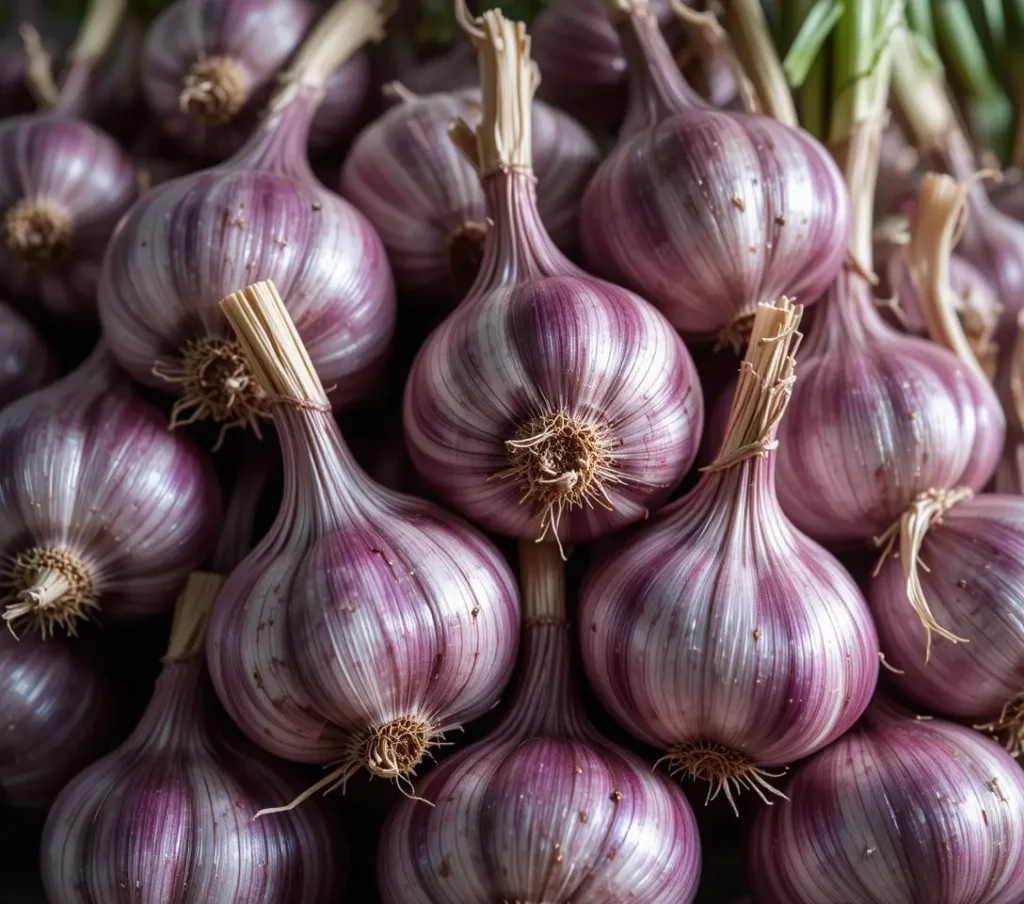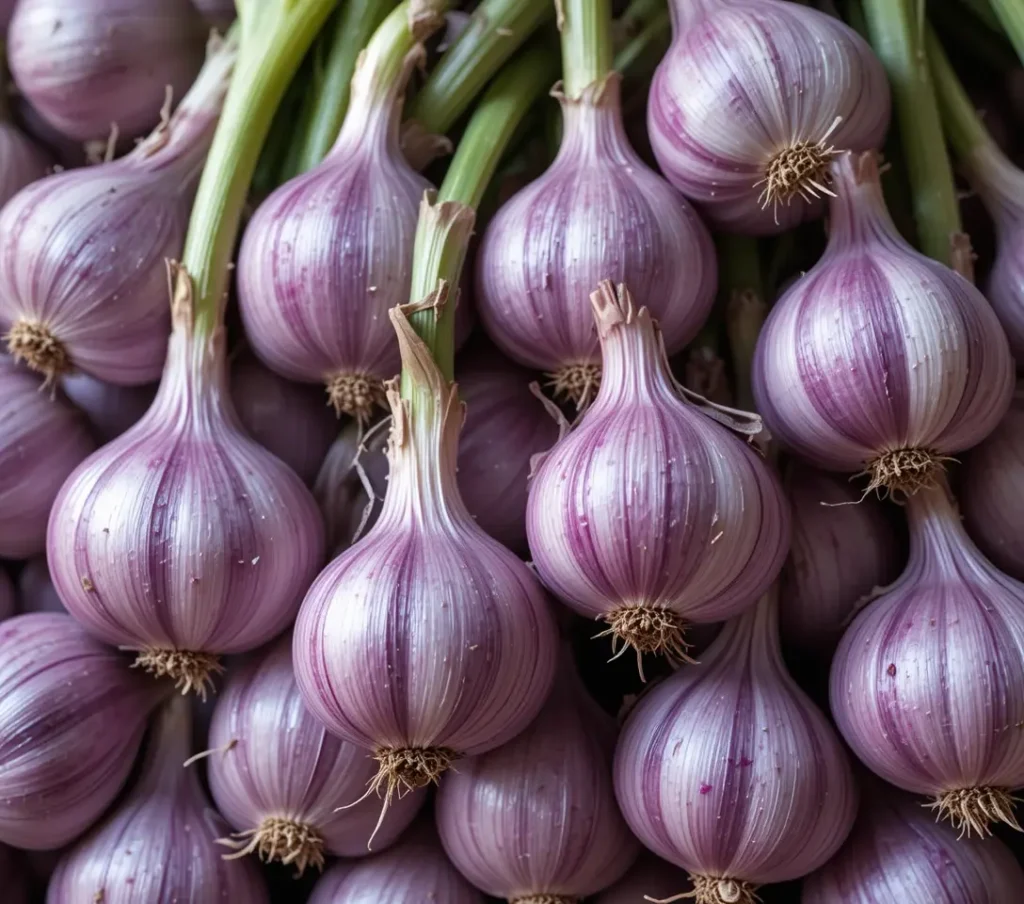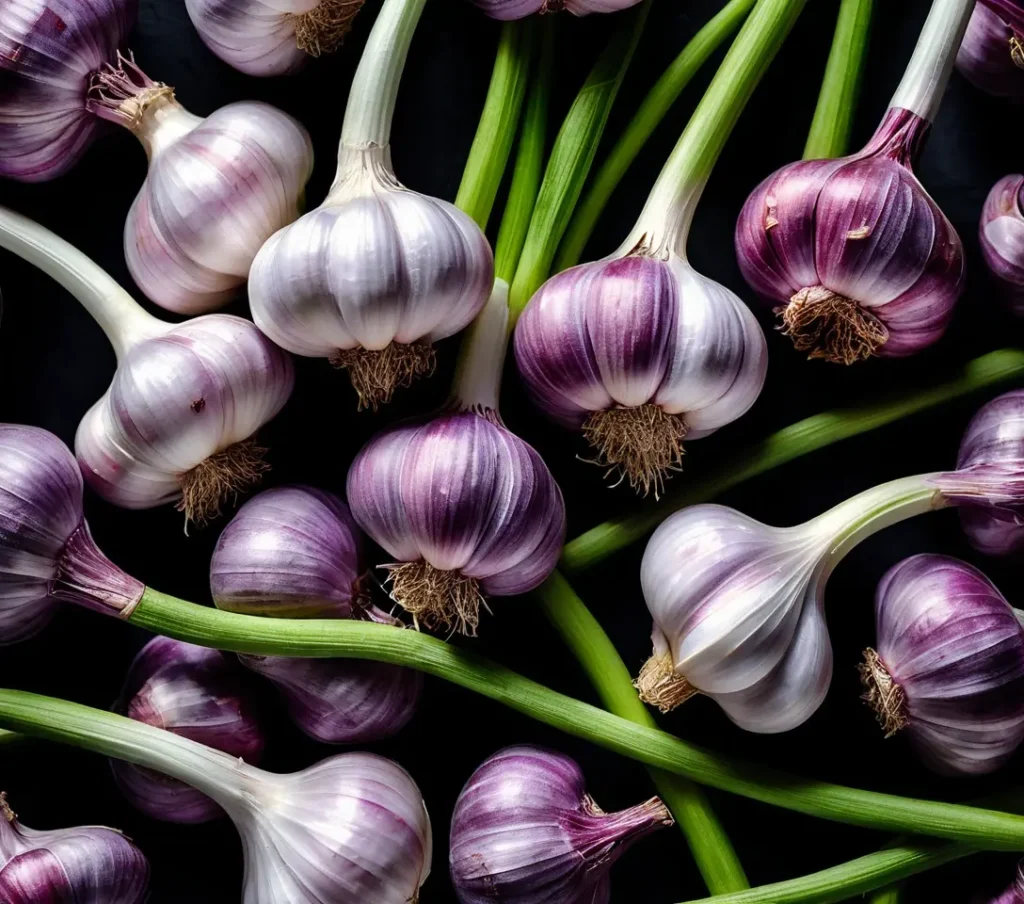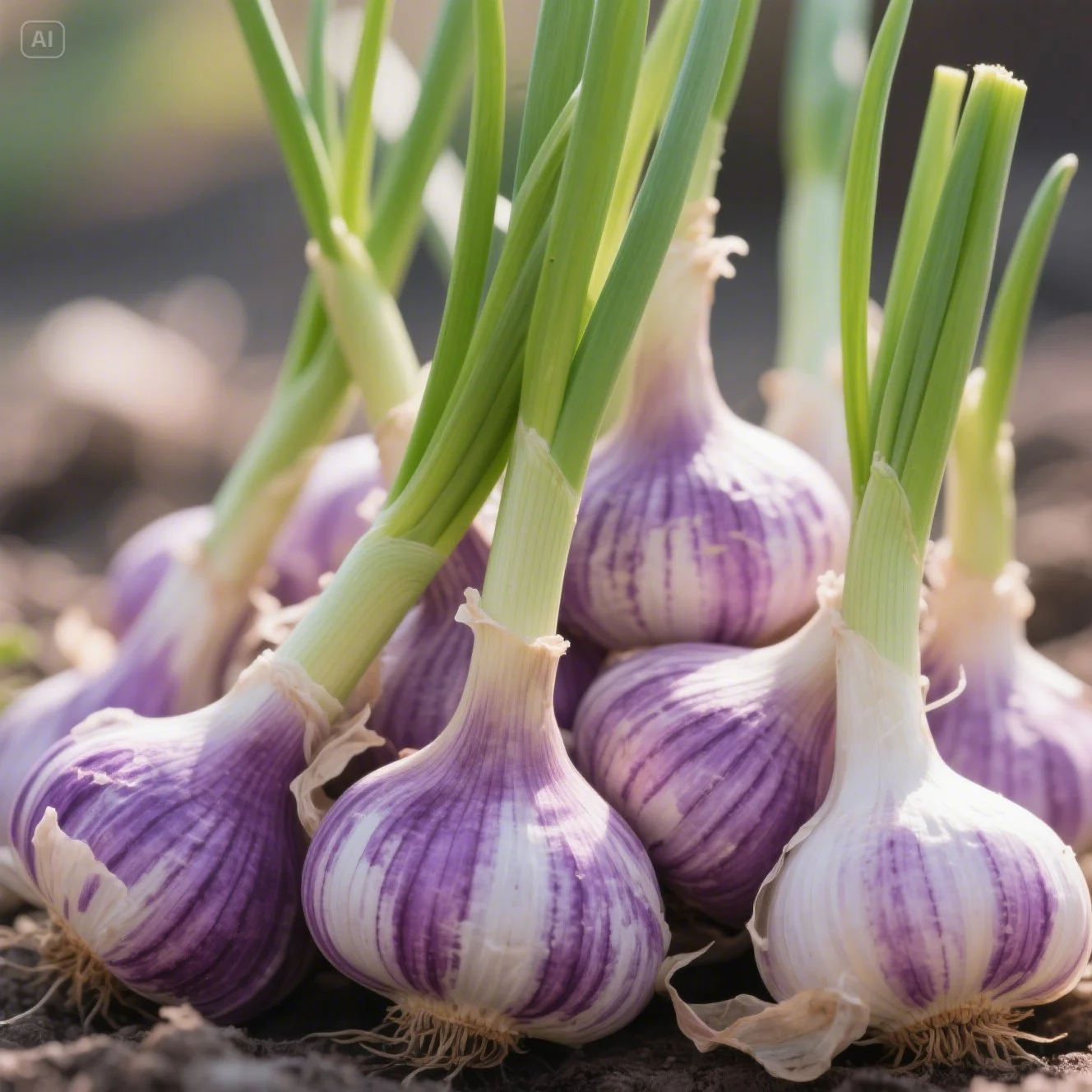Introduction
Imagine a garlic bulb that breaks the mold, purple streaks running through its skin, cloves that gleam like amethyst gems, and a flavor that dances between bold and subtly sweet. This isn’t your average garlic. Purple garlic stands out in looks and taste, making it a favorite among chefs, health enthusiasts, and home gardeners.
So, what exactly is this vibrant ingredient? Purple garlic (a type of hardneck garlic, Allium sativum) gets its striking color from natural pigments called anthocyanins, the same antioxidants found in blueberries and red cabbage. Unlike common white garlic, it boasts a milder heat, a touch of sweetness, and a nutrient profile that packs a punch.
But there’s more to this purple gem than meets the eye. In this guide, we’ll dig into:
- Why its vibrant color signals a treasure trove of health perks.
- How its complex flavor elevates dishes from simple to spectacular.
- Tips for growing, storing, and cooking with it like a pro.
Whether you’re a curious foodie or a gardener looking to spice up your crop lineup, purple garlic offers something special. Let’s unravel why this ingredient deserves a spot in your kitchen and your garden.
Key Takeaways
- Visual Appeal: The purple streaks aren’t just pretty they’re a mark of antioxidant richness.
- Flavor Twist: Expect a bold, garlicky punch with a sweeter finish compared to white varieties.
- Versatility: Perfect for roasting, pickling, or raw use in dressings and dips.
Why Trust This Guide?
I’ve explained all Its Unique Flavor, growing, Health Benefits, and uses you need to know about purple garlic. You’ll get practical advice, with no fluff or guesswork.
Ready to dive deeper? Let’s start with the basics.
What Exactly is Purple Garlic?

Purple garlic isn’t one specific type of garlic. Instead, it’s a category of garlic varieties defined by one standout feature: purple streaks or blotches on its papery outer wrappers or cloves. These bulbs range from soft lavender hues to deep violet stripes, making them a visual standout in farmers’ markets and kitchen pantries alike.
The Science Behind the Hue: Anthocyanins
The secret to purple garlic’s vibrant color lies in anthocyanins, natural pigments found in many purple, blue, and red plants. These compounds do more than paint garlic with pretty shades they’re also powerful antioxidants that protect plants from environmental stress. In purple garlic, anthocyanins concentrate in the wrappers and cloves, creating those signature purple streaks.
Fun fact: Anthocyanins are why blueberries are blue, red cabbage is red, and your purple garlic turns pale when cooked (heat breaks down the pigments!).
Popular Purple Varieties (Creole, Rocambole, etc.)
Not all purple garlic is the same. Here are three standout types to know:
Creole Garlic
- Type: Softneck (flexible stalks, ideal for braiding).
- Origin: Mediterranean regions.
- Traits: Bold, spicy flavor with a slow-building heat. Cloves have reddish-purple wrappers.
Rocambole Garlic
- Type: Hardneck (rigid central stalk, prized for complex flavors).
- Origin: Eastern Europe.
- Traits: Easy-to-peel cloves with purple-striped skins. Sweet, nutty flavor when roasted.
Spanish Roja
- Type: Hardneck.
- Origin: Spain.
- Traits: Large cloves with intense, lingering heat. Wrappers often show deep purple blotches.
Pro Tip: Hardneck varieties like Rocambole and Spanish Roja thrive in colder climates, while softneck Creole garlic prefers milder winters.
Why This Matters
- Gardeners: Choose varieties based on your climate and flavor preferences.
- Cooks: Experiment with Creole’s spice or Rocambole’s sweetness to elevate dishes.
Next up: Let’s explore how those anthocyanins and other compounds make purple garlic a health powerhouse.
Key Takeaways
- Anthocyanins give purple garlic its color and antioxidant benefits.
- Hardneck vs. Softneck: Hardnecks (e.g., Rocambole) offer richer flavors; softnecks (e.g., Creole) store longer.
- Spanish Roja is a top pick for bold, garlic-forward recipes.
Did You Know?
The purple streaks on garlic wrappers fade over time. For the brightest color, use fresh bulbs within 3–4 months of harvest.
Health Benefits and Nutritional Powerhouse

Purple garlic isn’t just a flavor booster it’s a nutritional powerhouse packed with compounds that support your health. Let’s break down what makes this colorful bulb a standout in your diet.
Rich in Antioxidants and Allicin
Two key players give purple garlic its health-boosting reputation: anthocyanins and allicin.
- Anthocyanins: These are the pigments responsible for purple garlic’s vibrant color. Like those in blueberries and red cabbage, they act as antioxidants, fighting free radicals that damage cells. Studies suggest they may reduce inflammation and lower the risk of chronic diseases.
- Allicin: When you chop or crush garlic, a reaction creates allicin, the compound behind its pungent smell. Allicin has antibacterial and antiviral properties, making it a natural ally for your immune system. It also helps regulate blood pressure and cholesterol levels.
Pro Tip: To maximize allicin, let chopped garlic sit for 10 minutes before cooking. Heat deactivates some compounds, so raw garlic delivers the strongest benefits.
Supporting Overall Wellness
Adding purple garlic to meals can contribute to long-term health in several ways:
Immune Support
Allicin and antioxidants work together to strengthen your body’s defenses. Regular consumption may help ward off common colds and infections.
Heart Health
Purple garlic supports cardiovascular wellness by:
- Improving blood flow.
- Reducing LDL (“bad” cholesterol).
- Helping regulate blood pressure.
Anti-Inflammatory Effects
Chronic inflammation links to conditions like arthritis and diabetes. Anthocyanins in purple garlic help calm inflammation at the cellular level.
How It Compares to White Garlic
Both types contain allicin, but purple garlic’s anthocyanins give it an edge. Think of it as white garlic’s healthier cousin similar benefits, plus extra antioxidant power.
Why This Matters
- Daily Use: Just 1–2 cloves a day can deliver noticeable benefits.
- Versatility: Raw, roasted, or fermented, each form offers unique advantages.
Next, we’ll explore how purple garlic’s distinct flavor makes it a kitchen favorite.
Key Takeaways
- Allicin boosts immunity and heart health.
- Anthocyanins add anti-inflammatory benefits missing in white garlic.
- Raw vs. Cooked: Raw garlic retains more allicin; cooking preserves anthocyanins.
Did You Know?
Purple garlic’s antioxidants stay stable when fermented. Try adding it to homemade kimchi or pickles for a gut-friendly punch!
The Distinctive Flavor Profile
Purple garlic surprises the palate with a flavor profile that’s both bold and nuanced. While it shares the classic garlicky punch of white varieties, its taste and aroma have unique twists that make it a chef’s secret weapon.
Comparing Pungency and Aroma
Purple garlic stands out for its balanced pungency. Here’s how it compares to white garlic:
- Raw Flavor:
- White Garlic: Sharp, fiery heat that lingers.
- Purple Garlic: Starts with a milder kick, followed by subtle sweet undertones. Think of it as “garlic with manners.”
- Aroma:
- White Garlic: Intense, sharp scent that dominates a room.
- Purple Garlic: Earthy and slightly floral, with a less overpowering smell.
Why It Matters:
Purple garlic’s smoother raw flavor makes it ideal for dishes where garlic takes center stage like fresh pesto or aioli without overwhelming other ingredients.
Flavor When Raw vs. Cooked
How you prepare purple garlic dramatically changes its taste:
Raw Purple Garlic
- Profile: Assertive but less harsh than white garlic, with a peppery zing.
- Best Uses:
- Minced in salad dressings.
- Thinly sliced in salsa or ceviche.
Roasted or Cooked Purple Garlic
- Profile: Heat transforms it into a sweet, caramelized delight. The anthocyanins mellow, leaving a rich, umami depth.
- Best Uses:
- Spread on crusty bread.
- Blended into soups or mashed potatoes.
Pro Tip: Roast whole bulbs drizzled with olive oil at 400°F (200°C) for 30 minutes. The cloves turn buttery-soft and spreadable.
Key Takeaways
- Raw: Milder heat with a peppery-sweet edge.
- Cooked: Develops deep sweetness, perfect for savory-sweet dishes.
- Versatility: Works in raw and cooked applications where subtlety matters.
Did You Know?
Purple garlic’s sweetness when roasted pairs beautifully with honey-glazed meats or balsamic-roasted veggies. Try it in a fig-and-goat-cheese tart for a gourmet twist!
Why This Matters for Home Cooks
- Less Overpowering: Lets you use more garlic without fear of overwhelming a dish.
- Kid-Friendly: The sweeter cooked flavor appeals to picky eaters.
Up next: Discover practical tips for cooking with purple garlic, from mincing hacks to flavor pairings.
Flavor Cheat Sheet
| Preparation | Taste | Best Pairings |
|---|---|---|
| Raw | Peppery, mild heat | Citrus, herbs, olive oil |
| Roasted | Sweet, umami-rich | Root veggies, cheeses, honey |
| Sautéed | Nutty, robust | Mushrooms, meats, grains |
Cooking with Purple Garlic: Tips and Ideas
Purple garlic’s unique flavor profile opens up a world of culinary possibilities. Whether raw, roasted, or infused, this vibrant ingredient can elevate everyday meals. Let’s explore practical ways to make the most of it in your kitchen.
Best Ways to Use Purple Garlic in Your Kitchen
Purple garlic’s milder raw bite and sweet cooked flavor make it incredibly versatile. Here’s how to match its strengths to your dishes:
- Raw: Perfect for fresh applications where subtlety matters.
- Cooked: Shines in slow-cooked or roasted dishes that benefit from sweetness.
- Infused: Adds depth to oils, broths, and marinades.
Using Raw Purple Garlic (Think Pestos & Dressings)
Raw purple garlic delivers a gentle heat that won’t overpower other ingredients. Try these ideas:
- Pestos & Sauces: Blend 2–3 cloves with basil, pine nuts, and olive oil for a balanced pesto.
- Salad Dressings: Mince finely into vinaigrettes or yogurt-based dips.
- Finishing Touch: Sprinkle thin slices over pizza or grilled veggies for a fresh kick.
Why It Works: The milder raw flavor lets you use more garlic without overwhelming delicate herbs or citrus.
Roasting, Sautéing, and Infusing
Heat unlocks purple garlic’s sweet, nutty side. Here’s how to master cooked applications:
- Roasting
- Method: Slice off the bulb’s top, drizzle with oil, wrap in foil, and bake at 400°F (200°C) for 30–40 minutes.
- Uses: Spread soft cloves on bread, mix into hummus, or stir into mashed potatoes.
- Sautéing
- Tip: Add minced garlic to hot oil for 30 seconds to infuse flavor into stir-fries or pasta sauces without burning.
- Pairings: Complements mushrooms, spinach, and tomatoes beautifully.
- Infusing Oils
- How-To: Simmer cloves in olive oil on low heat for 10 minutes. Strain and store for up to two weeks.
- Uses: Drizzle over soups, roasted meats, or crusty bread.
Pro Tip: For a quick appetizer, toss roasted purple garlic cloves with honey and thyme, then serve with goat cheese.
Flavor Pairing Cheat Sheet
| Application | Ingredients to Pair |
|---|---|
| Raw | Lemon, parsley, avocado, feta |
| Roasted | Balsamic vinegar, rosemary, squash |
| Sautéed | Ginger, soy sauce, bell peppers |
Why This Matters
- Waste Reduction: Use leftover peels to flavor stocks (simmer with onion skins and herbs).
- Meal Prep: Roast multiple bulbs at once; store cloves in the fridge for up to a week.
Ready to grow your own purple garlic? Up next, we’ll cover planting tips and storage hacks to keep your harvest fresh.
Key Takeaways
- Raw: Ideal for dressings and light sauces.
- Roasted: Adds sweetness to dips and spreads.
- Infused Oils: Elevate dishes with minimal effort.
Did You Know?
Purple garlic’s low water content makes it ideal for fermenting. Try adding cloves to homemade pickles for a tangy, probiotic boost!
Growing and Storing Your Purple Gems
Growing your purple garlic guarantees the freshest bulbs and access to rare varieties you won’t find in stores. Plus, it’s surprisingly simple even for beginners. Here’s how to nurture these flavorful bulbs from soil to plate.
Why Grow Purple Garlic?
- Freshness: Homegrown garlic tastes brighter and more complex than store-bought.
- Variety: Grow unique types like Spanish Roja or Creole that supermarkets rarely stock.
- Cost-Effective: One bulb planted in fall yields 8–10 cloves by summer.
Growing Basics: Planting to Harvest
1. Planting Time
- When: Plant cloves 4–6 weeks before your first hard frost (usually late fall).
- Why: Cold temperatures trigger root growth for robust spring sprouts.
2. Soil Requirements
- Type: Loose, well-draining soil mixed with compost.
- pH: Slightly acidic to neutral (6.0–7.0).
3. Planting Steps
- Break bulbs into cloves, keeping papery wrappers intact.
- Plant cloves pointy-end up, 2 inches deep, 6 inches apart.
- Cover with mulch (straw or leaves) to insulate over winter.
4. Harvesting Cues
- When: Mid-summer, when lower leaves turn yellow/brown.
- How: Gently loosen soil with a fork and pull bulbs by the stem.
Hardneck Specific: Managing Scapes
Most purple garlic varieties are hardneck, meaning they grow curly flower stalks called scapes.
- Why Remove Them: Cutting scapes redirects energy to bulb growth, boosting size by 20–30%.
- When: Snip scapes once they form 1–2 loops.
- Don’t Waste Them: Chop scapes into pestos, stir-fries, or pickles for a mild garlic flavor.
Buying and Storing Purple Garlic
Buying Tips
Choose bulbs that are:
- Firm and Heavy: Avoid lightweight or spongy bulbs.
- Dry Wrappers: No signs of mold or dampness.
- Plump Cloves: Skip bulbs with shriveled or sprouted cloves.
Storing Tips
- Ideal Conditions: Keep in a cool (60–65°F), dry, dark place with airflow (e.g., mesh bag, wire basket).
- Shelf Life:
- Hardneck: 4–6 months (use sooner for best flavor).
- Softneck: 6–12 months (braid stems for easy storage).
Pro Tip: Cure freshly harvested bulbs in a shaded, ventilated spot for 2–3 weeks before storing. This toughens wrappers and prevents rot.
Key Takeaways
- Plant in Fall: Cold exposure is key for hardneck varieties.
- Remove Scapes: Grow bigger bulbs and enjoy edible scapes.
- Store Smart: Hardneck garlic lasts half as long as softneck garlic; plan meals accordingly.
Did You Know?
Garlic grown in poor soil produces smaller bulbs. Amend beds with compost or aged manure each fall for a bumper crop.
Why This Matters
- Gardeners: Control quality from seed to harvest.
- Cooks: Freshly dug garlic has a juicier, sweeter taste than aged bulbs.
Next, we’ll compare purple vs. white garlic to help you choose the right type for your needs.
Quick Storage Fix
If your garlic starts sprouting, plant the cloves in pots for fresh greens! They add mild garlic flavor to salads and soups.
Purple Garlic vs. White Garlic: What’s the Difference?

Choosing between purple garlic and white garlic isn’t just about color; it affects flavor, storage, and even how you grow it. Let’s break down their key differences to help you pick the right bulb for your needs.
Appearance
- Purple Garlic: Recognizable by purple streaks or blotches on its wrappers and cloves. The intensity varies by variety.
- White Garlic: Uniformly white or off-white skin, with no pigmentation.
Flavor & Aroma
| Trait | Purple Garlic | White Garlic |
|---|---|---|
| Raw Flavor | Milder heat, subtle sweetness | Sharper, more pungent |
| Cooked Flavor | Sweet, caramelized, nutty | Bold, lingering garlicky punch |
| Aroma | Earthy, less overpowering | Strong, sharp |
Note: Flavor varies by variety. For example, Creole purple garlic can be spicier than some white types.
Texture & Storage
- Purple Garlic:
- Type: Mostly hardneck varieties.
- Shelf Life: 4–6 months (shorter due to fewer protective layers).
- Bonus: Produces edible scapes (flower stalks) in spring.
- White Garlic:
- Type: Mostly softneck varieties.
- Shelf Life: 6–12 months (longer, ideal for braiding).
- Bonus: No scapes, but easier to grow in warm climates.
Cultivation
- Purple Garlic (Hardneck):
- Thrives in colder climates (USDA zones 1–5).
- Requires winter chilling to form bulbs.
- White Garlic (Softneck):
- Grows best in mild winters (USDA zones 6–9).
- Tolerates drought better than hardnecks.
Nutritional Differences
Both types offer allicin (immune-boosting compound), but purple garlic has an extra edge:
- Anthocyanins: These antioxidants (found in purple/blue foods) may reduce inflammation and oxidative stress.
- Similar Benefits: Both support heart health, immunity, and blood sugar regulation.
Key Fact: Purple garlic isn’t “healthier”; it adds extra antioxidants to the same core benefits.
Cheat Sheet: Which Should You Choose?
| Scenario | Pick Purple Garlic | Pick White Garlic |
|---|---|---|
| Short-term storage | ❌ | ✔️ (Lasts up to a year) |
| Bold raw flavor | ❌ | ✔️ |
| Gourmet recipes | ✔️ (Complex sweetness) | ❌ |
| Warm climates | ❌ | ✔️ |
| Edible scapes | ✔️ | ❌ |
Key Takeaways
- Flavor: Purple garlic is milder raw and sweeter cooked; white garlic packs a sharper punch.
- Storage: White garlic lasts longer; use purple garlic within 6 months.
- Growing: Purple (hardneck) suits cold climates; white (softneck) prefers warmth.
Pro Tip: Grow both types! Plant hardneck purple garlic for fall harvests and softneck white garlic for spring braids.
Next up: Avoid common pitfalls with 5 mistakes to skip when growing or cooking with purple garlic.
Did You Know?
Purple garlic’s shorter shelf life makes it a seasonal treat stock up at farmers’ markets in late summer!
5 Mistakes to Avoid with Purple Garlic
Even seasoned gardeners and cooks can stumble with purple garlic. Avoid these common pitfalls to ensure your bulbs thrive in the garden and shine in the kitchen.
1. Overwatering Your Plants
What Happens:
- Excess moisture causes rotten bulbs and fungal infections (like white rot).
- Leaves turn yellow prematurely.
Fix It:
- Water only when the top inch of soil is dry.
- Use well-draining soil or raised beds to prevent soggy roots.
2. Planting Cloves Too Shallow
What Happens:
- Shallow cloves (less than 2 inches deep) risk frost heave in winter.
- Bulbs grow smaller due to unstable roots.
Fix It:
- Plant cloves pointy-end up, 2 inches deep.
- Cover with mulch to insulate against temperature swings.
3. Ignoring Soil Drainage
What Happens:
- Poor drainage leads to bulb splitting and stunted growth.
- Cloves may develop mold or fail to sprout.
Fix It:
- Mix sand or compost into heavy clay soil.
- Avoid planting in low-lying areas where water pools.
4. Harvesting Too Early
What Happens:
- Bulbs harvested too soon have thin wrappers and shorter shelf life.
- Cloves lack full flavor development.
Fix It:
- Wait until ⅔ of the leaves turn brown.
- Dig up a test bulb first if wrappers are tight, it’s ready!
5. Skipping the Curing Process
What Happens:
- Uncured bulbs rot quickly or develop mold during storage.
- Flavors remain harsh and undeveloped.
Fix It:
- Cure bulbs in a shaded, ventilated spot for 2–3 weeks.
- Trim roots and stems only after curing.
Troubleshooting Cheat Sheet
| Mistake | Signs to Watch For | Quick Solution |
|---|---|---|
| Overwatering | Mushy bulbs, yellow leaves | Reduce watering; improve drainage |
| Shallow Planting | Frost-heaved cloves | Replant deeper next season |
| Poor Soil Drainage | Splitting bulbs | Amend soil with compost |
Key Takeaways
- Water Wisely: Garlic hates wet feet—less is more.
- Cure Properly: Never skip curing; it’s key for flavor and storage.
- Timing Matters: Patience rewards you with plump, flavorful bulbs.
Pro Tip: Rotate garlic planting sites every 2–3 years to prevent soil-borne diseases. Follow with legumes like beans to replenish nitrogen.
Did You Know?
Garlic planted too close to onions competes for nutrients. Keep them at least 12 inches apart!
Why This Matters
- Gardeners: Avoid wasted harvests and boost yields.
- Cooks: Properly cured garlic tastes sweeter and lasts longer.
Next, we’ll wrap up with final thoughts and answer your burning FAQs about purple garlic.
Act Fast! If you spot aphids on leaves, spray them with diluted dish soap (1 tsp per quart of water) to protect your crop.
Conclusion
Purple garlic isn’t just another ingredient it’s a vibrant, flavorful powerhouse that deserves a spot in your kitchen and garden. Let’s recap why this colorful bulb stands out:
- Unique Color & Science: Its purple streaks come from anthocyanins, antioxidants also found in blueberries and red cabbage. These pigments do more than dazzle, they fight inflammation and oxidative stress.
- Health Perks: Packed with allicin (the compound behind garlic’s immune-boosting punch) and extra antioxidants, it supports heart health, immunity, and overall wellness.
- Flavor Flexibility: Milder raw heat and sweet, nutty notes when cooked make it a versatile upgrade for pestos, roasts, and infused oils.
- Gardener’s Gem: Cold-hardy hardneck varieties thrive in chilly climates and reward you with edible scapes in spring.
Why Give Purple Garlic a Try?
Whether you’re sautéing cloves for a weeknight stir-fry or planting bulbs for a summer harvest, purple garlic offers:
- Visual Drama: Brighten dishes with its jewel-toned cloves.
- Nutritional Edge: Extra antioxidants without sacrificing classic garlic benefits.
- Culinary Creativity: Experiment with raw zest or caramelized sweetness.
Your Turn!
Have you cooked with purple garlic or grown it in your garden? Share your favorite recipes, success stories, or questions in the comments below!
Call to Action:
- Spread the Love: Know a garlic enthusiast? Share this guide with them.
- Stay Curious: Try a new purple garlic variety this season your taste buds (and garden) will thank you!
Final Thought
From its striking appearance to its subtle complexity, purple garlic proves that sometimes, the most ordinary ingredients hold extraordinary secrets. Give it a chance, and you might never go back to plain white bulbs.
Key Takeaways
- Color = Antioxidants: The purple hue signals added health benefits.
- Flavor Chameleon: Adapts to raw and cooked dishes with ease.
- Grower-Friendly: Perfect for cold climates and gardeners craving variety.
Now, grab a bulb and start exploring your next culinary or gardening adventure awaits!
FAQs
Can I substitute purple garlic for white garlic in recipes?
Yes! Use it 1:1, but expect a milder raw flavor and sweeter cooked taste. Adjust quantities to suit your preference, add an extra clove or two for boldness.
How long does purple garlic last?
– Unpeeled bulbs: 4–6 months in a cool, dark, ventilated spot.
– Peeled cloves: 1 week in the fridge (store in an airtight container)
Can I grow purple garlic in warm climates?
Most hardneck purple garlic needs cold winters. For warm zones (7+), try softneck Creole varieties or chill cloves in the fridge for 4–6 weeks before planting.
Are the health benefits of purple garlic better than white garlic?
Both types offer allicin and heart-healthy compounds, but purple garlic adds anthocyanins (extra antioxidants). Think of it as a nutritional bonus, not a replacement.
What’s the best way to peel purple garlic cloves?
1- Smash cloves gently with the flat side of a knife—the skin loosens instantly.
2-For whole cloves, blanch in hot water for 30 seconds to soften wrappers.
Can I plant store-bought purple garlic?
Maybe. Store garlic is often treated to prevent sprouting. Buy seed garlic from nurseries or farmers’ markets for reliable results.
.Quick Tips Recap
- Storage Hack: Keep bulbs in a mesh bag in your pantry for airflow.
- Gardeners: Rotate garlic crops yearly to avoid soil diseases.
- Cooks: Roast whole bulbs to mellow the flavor for spreads or soups.
Got more questions? Drop them in the comments, we’re here to help!

0 thoughts on “Purple Garlic: The Ultimate Guide You Should Know Now”